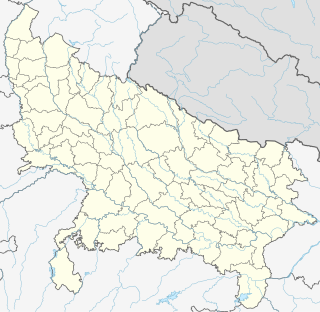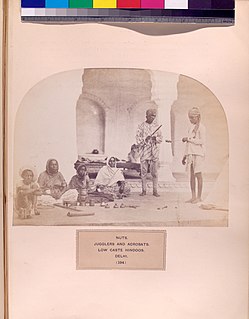
Sherpur is a region or a pargana of 'Sikarwar Vansh' in the Mohammadabad tehsil of Ghazipur district in Uttar Pradesh. It consists of Sherpur Kalan, Sherpur Khurd, Narainpur, Semra, Surtapur, Jamalpur, Nizampur, Firozpur, villages which were established by the descendants of Dullah Rai. It has population of 31322 as per 2011 Census.
The Manihar (मनिहार) are a Muslim community, found mainly in North India.
The Muslim Gaddi are a Muslim community found mainly in northern India. After the independence in 1947, the Gaddi of the states of Haryana and Delhi migrated to Pakistan and are now found in the provinces of Punjab and Sindh. In Pakistan, the community is often referred to as Gaddi.
The Ghosi are a Muslim community found mainly in North India.
The Muslim Teli are members of the Teli caste who follow Sunni Islam. They are found in India and Pakistan.
The Momin Qassar are a South Asian community traditionally involved in washing clothes. They are considered to be Muslim converts from the Hindu Dhobi caste, and are found in North India and Pakistan. The community is also known as Charhoa and Gazar in Pakistan and Momin Qassar in India. They also use surname as "Hawari".
The Mirasi are the genealogists and traditional singers and dancers of low caste natives. The word "mirasi" is derived from the Arabic word (ميراث) mīrās, which means inheritance or sometimes heritage.

The Chero is a caste found in the states of Bihar, Jharkhand and Uttar Pradesh in India.
The Khanzada or Khan Zadeh are a community of Muslim Rajputs found in the Awadh region of Uttar Pradesh, India. This community is distinct from the Rajasthani Khanzada Rajput, the descendants of Wali-e-Mewat Raja Naher Khan, who are a sub-clan of Jadaun gotra. They are also a community of Muslim Rajputs. They refer to themselves as Musalman Rajputs. After the Partition of India in 1947, many members of this community migrated to Pakistan.
The Muley Jat, also Mola Jat and Mula Jat, are a community descended from Jats in Islam, found mainly in the states of Uttar Pradesh, Haryana and Delhi in India, and the province of Punjab in Pakistan. They are predominantly Muslim.
The Khokhar Khanzada are muslim community found mainly in the Nagaur District of Rajasthan and Fatehpur district of Uttar Pradesh in India. They have no connection with the Ranghar Khokhar of Moradabad district in western Uttar Pradesh, another community of Muslim Khokhars settled in Uttar Pradesh. The Khokhar are a well known tribe, found mainly in the Punjab region of Pakistan and India. The Khokhar Khanzada are a sub-community within the larger Khanzada community of eastern Uttar Pradesh.
The Patharkat are a Hindu sub-caste found in North India. The majority of this subcaste in Nepal, Kushbadiya, speak a poorly known language, and exhibit enough distinct cultural values to be a separate ethnic group, nevertheless Pattharkat in Kapilbastu District are exceptional as they considered themselves to be Dalit rather than adivasi. In India, they are also known as Sangtarash.
The Ramaiya are a caste found in the state of Uttar Pradesh in India. Many members of this community migrated to Pakistan in 1947 and have settled in Punjab.

The Nat are a Hindu caste found in northern India.
Nalband is a Persian and Urdu word with the meaning manufacturer of horseshoes. The word is derived from the Persian word nal, meaning horseshoe and band, a fastener.
The Bharbhunja/ Bhurji/ Bhojwal/ bhujwa are a largely Hindu caste found in North India and Maharashtra. They are also known as Kalenra in Maharashtra, Mehra in Punjab and in Uttar Pradesh. A small number are also found in the Terai region of Nepal.
The Dabgar are a Hindu caste found in the states of Uttar Pradesh, Rajasthan and Gujarat in India. They were the follower of Shiva. According to their traditions, they were originally found in Rajasthan and were soldiers. In Rajasthan, the community prefer to call themselves Dhalgar.
The Kanmailia are a Muslim community found in the state of Uttar Pradesh in India. Their preferred self-designation is Shaikh.
The Kuthaliya Bora are a Hindu caste found in the state of Uttarakhand in India. They are also known as Bora Karki.
The Patari are a community found mainly in the Sonbhadra district of Uttar Pradesh, India.


